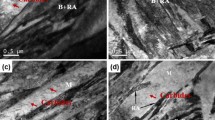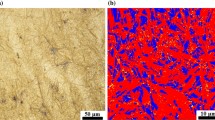Abstract
The effects of heat treatment and of the presence of primary carbides on the fracture toughness,K Ic and the fatigue crack growth rates,da/dN, have been studied in M-2 and Matrix II high speed steels. The Matrix II steel, which is the matrix of M-42 high speed steel, contained many fewer primary carbides than M-2, but both steels were heat treated to produce similar hardness values at the secondary hardening peaks. The variation of yield stress with tempering temperature in both steels was similar, but the fracture toughness was slightly higher for M-2 than for Matrix II at the secondary hardening peaks. The presence of primary carbides did not have an important influence on the values ofK Ic of these hard steels. Fatigue crack growth rates as a function of alternating stress intensity, ΔK, showed typical sigmoidal behavior and followed the power law in the middle-growth rate region. The crack growth rates in the near threshold region were sensitive to the yield strength and the grain sizes of the steels, but insensitive to the sizes and distribution of undissolved carbides. The crack growth rates in the power law regime were shifted to lower values for the steels with higher fracture toughness. SEM observations of the fracture and fatigue crack surfaces suggest that fracture initiates by cleavage in the vicinity of a carbide, but propagates by more ductile modes through the matrix and around the carbides. The sizes and distribution of primary carbides may thus be important in the initiation of fracture, but the fracture toughness and the fatigue crack propagation rates appear to depend on the strength and ductility of the martensite-austenite matrix.
Similar content being viewed by others
References
B.L. Averbach:Metal Progress, 1980, vol. 118, no. 8, pp. 19–24.
J. A. Rescalvo and B. L. Averbach:Metall. Trans. A, 1979, vol. 10A, pp. 1265–71.
L. R. Olsson and F. Fischmeister:Powder Met., 1978, vol. 21, pp. 13–28.
S.C. Lee and F.J. Worzala:Metall. Trans. A, 1981, vol. 12A, pp. 1477–84.
K. Eriksson:Scand. J. Metall., 1973, vol. 2, pp. 197–203.
E.A. Almond and R.S. Irani:Powder Met., 1981, vol. 24, pp. 105–13.
ASTM E399-81, “Standard Test Method for Plane Strain Fracture Toughness of Metallic Materials,” Amer. Soc. for Testing and Materials, 1981, Philadelphia, PA.
J. Durnin and K. A. RActal:J. Iron Steel Inst., 1968, vol. 206, pp. 60–67.
G. Berry and M. J. Kadhim Al-Tornachi:Metals Technology, 1977, pp. 289-95.
G. R. Speich, D. S. Dabrowski, and L. F. Porter:Metall. Trans., 1973, vol. 4, pp. 303–15.
R.O. Ritchie:Metal Science, 1977, vol. 11, pp. 368–81.
R.O. Ritchie, F. A. McClintock, H. N-Hashemi, and M. A. Ritter:Metall. Trans. A, 1982, vol. 13A, pp. 101–10.
K. Tanaka and T. Mura:Metall. Trans. A, 1982, vol. 13A, pp. 111–16.
Author information
Authors and Affiliations
Rights and permissions
About this article
Cite this article
Lou, B., Averbach, B.L. Fracture toughness and fatigue behavior of matrix II and M-2 high speed steels. Metall Trans A 14, 1889–1898 (1983). https://doi.org/10.1007/BF02645560
Received:
Issue Date:
DOI: https://doi.org/10.1007/BF02645560




